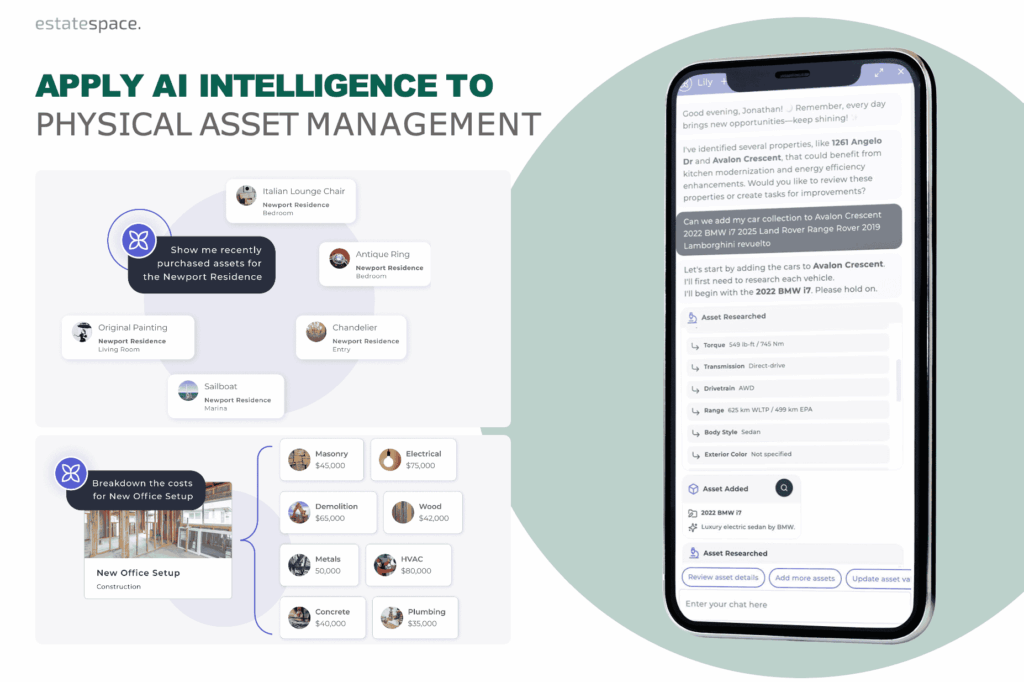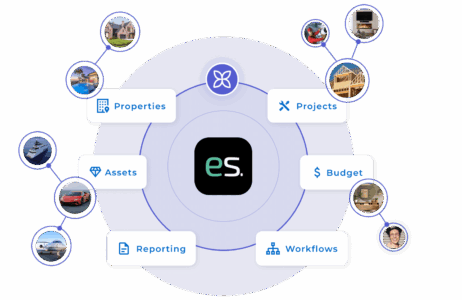Seasonal Maintenance Checklist for Estate Managers: Your Complete Guide
You know the drill. Spring arrives, and suddenly you’re juggling dozens of seasonal maintenance tasks across multiple properties. As an estate manager, you’re fielding texts from contractors, searching through email chains for last year’s vendor quotes, and updating spreadsheets that never capture the full picture of your seasonal maintenance checklist.
Sound familiar?
For estate managers and private service professionals, seasonal transitions are when everything surfaces at once—and when the cracks in manual systems become painfully obvious. One missed irrigation winterization. One delayed roof inspection. One vendor who didn’t show up because the work order got lost in your inbox. These aren’t just inconveniences—they’re risks to the assets you’re trusted to protect.
The Hidden Cost of Manual Maintenance for Estate Managers
Here’s what most asset managers won’t admit publicly: traditional maintenance management is broken.
When you’re coordinating seasonal tasks across estates using a patchwork of emails, texts, spreadsheets, and siloed point solutions, you’re not really managing maintenance—you’re constantly reacting to it.
Consider what happens during a typical spring-to-fall transition. Vendor schedules live in your email, while task status lives in a spreadsheet, and property history lives… somewhere. You’re manually tracking which contractor serviced which system at which property last season. Client requests come via text while you’re looking at last year’s notes in a different system. Emergency repairs happen because preventive work fell through the cracks.
The real cost isn’t just your time—though 60% of admin work could be cut. It’s the emergency repairs that could’ve been stopped, the vendor relationships that suffer from poor coordination, and the inability to show your strategic value to clients who expect institutional-grade oversight.
Research shows that proactive seasonal maintenance planning prevents sudden expenses and assists in better financial management of property-related costs Top Property Management Tips Every Landlord Should Know, yet most estate managers lack the systems to execute consistently across their portfolios.
Spring Estate Maintenance Checklist: Transition from Winter to Active Care
Let’s walk through what proactive seasonal care actually looks like when you have the right systems in place. This seasonal maintenance checklist for estate managers helps you stay ahead of problems rather than reacting to emergencies.
Your properties are emerging from winter, and inspection timing is critical. Rather than hoping you remember every task, AI-powered workflows can automatically schedule irrigation activation and testing, roof checks after winter, and exterior surface reviews including stonework, siding, and paint. Tree health inspections for storm damage and outdoor lighting system checks round out the essential exterior work that prevents costly surprises later.
High-value amenities require special attention during spring prep. Pool and spa de-winterization sets chemistry baselines for the season ahead, while tennis court condition checks determine resurfacing needs. Outdoor kitchens need deep-cleaning and equipment testing, and furniture requires restoration before the guest season begins.
The HVAC transition isn’t just flipping a switch—it’s ensuring optimal performance through heating-to-cooling mode changeover with full service, air filter cleaning and replacement, smart thermostat programming for efficiency, and indoor air quality checks.
Summer Property Care Guide: Active Preservation Mode
This is when properties are in full use and maintenance becomes both visible and urgent. Centralized tracking ensures nothing slips through the cracks during peak season.
Water management demands vigilance. Weekly pool chemistry monitoring with automated alerts keeps recreational spaces safe and inviting. Irrigation scheduling based on weather data conserves resources while maintaining landscape health. Fountain and water feature activation creates the ambiance clients expect, while mid-season pump and filtration inspections prevent equipment failures during heavy use.
Strategic landscape care prevents costly replacement down the line. Integrated pest management protocols protect your investment without harsh chemicals. Specialty garden calendars ensure roses, vegetables, and formal gardens receive attention at precisely the right time. Tree health checks before storm season identify hazards early, and strategic lawn rotation schedules maintain pristine conditions throughout summer’s demands.
When properties are entertaining, every detail matters. Outdoor venue prep and maintenance ensure flawless events. Entry point and high-visibility area plantings create lasting impressions. Recreation equipment—from boats to vehicles to sports equipment—receives preventive care that keeps everything running smoothly.
Fall Maintenance Checklist: Preparing Your Properties for Winter
This is where proactive estate managers shine—preparing before problems emerge. Predictive maintenance means staying ahead of weather rather than reacting to damage. This seasonal maintenance checklist for estate managers ensures winter readiness.
Critical fall priorities include:
- Phased irrigation winterization before the first freeze
- Full drainage assessment and clearing
- Pool and water feature protection planning
- Chimney and fireplace safety inspections
- Exterior cleaning before winter weather arrives
Protecting your landscape investment for next season requires fall fertilization programs that support spring growth. Professional tree care before winter storms removes hazards and strengthens valuable specimens. Snow removal contractor coordination and contracts lock in reliable service before the rush. Landscape lighting review for shortened days ensures safety and security as darkness arrives earlier.
Interior system prep includes transitioning HVAC to heating mode with full service and property-wide humidity control that protects art and furnishings. Indoor air quality optimization and mechanical system load testing before peak demand ensure comfort throughout winter months.
Why Traditional Methods Fail Property Professionals
The challenge isn’t knowing what to do—you already know that. The challenge is executing consistently across multiple properties while maintaining visibility, vendor coordination, and client communication.
Spreadsheets can’t:
- Alert you 90 days before a seasonal vendor needs scheduling
- Track which contractor performed which service at which property
- Generate client reports showing proactive care versus reactive repairs
- Maintain warranty information and service history in one searchable location
Email chains can’t provide real-time status on 47 open tasks or automatically escalate overdue items. They can’t calculate actual spend versus budget allocations or create accountability when vendors miss scheduled appointments. The constant searching and forwarding wastes hours every week.
Point solutions can’t unify property management, project transition, and vendor coordination. They can’t provide portfolio-level insights across all managed assets or support the sophisticated reporting that justifies premium service fees. Each tool solves one problem while creating integration nightmares.
According to industry research on property management best practices, implementing systematic seasonal maintenance routines plays a critical role in preserving property condition while avoiding sudden, costly expenses.
How AI Technology Streamlines Your Workflow
Modern estate management platforms powered by AI transform seasonal maintenance from admin burden to strategic advantage.
Imagine this workflow:
- AI schedules seasonal tasks 60-90 days ahead based on property history and regional climate
- Automated vendor coordination sends work orders with property specs and access information
- Real-time status tracking shows what’s complete, in-progress, or overdue across your portfolio
- Predictive alerts flag potential issues before they become emergencies
- Client reporting generates automatically, showing proactive care and cost avoidance
This isn’t theory—it’s how sophisticated private service professionals are working today.
Your Action Plan: Moving from Reactive to Strategic Management
You don’t have to overhaul everything at once. Start with what’s most painful. Here’s your action plan for implementing a better seasonal maintenance checklist for estate managers.
Immediate actions you can take this week:
Begin by auditing your current system. Where do tasks fall through? Which properties have incomplete maintenance history? These gaps reveal your highest vulnerabilities. Then identify your highest-risk transitions—which seasonal changes create the most emergency repairs? Understanding patterns helps prioritize improvements. Map your vendor network to see who you rely on for seasonal work and where the gaps exist.
Strategic moves for the next quarter:
Move toward improvements by centralizing your maintenance data. Stop recreating schedules every season from scattered sources. Implement predictive scheduling using historical data to plan 60-90 days ahead. Create accountability systems ensuring vendors and internal teams have clear expectations and consequences.
Long-term transformation:
Explore purpose-built solutions like AI-powered platforms designed specifically for high-value asset management. Calculate your current costs by comparing emergency repairs versus preventive maintenance investment. Demonstrate strategic value by showing clients how proactive care protects their assets and justifies your premium positioning.
Becoming a Strategic Asset Steward
The estate managers who command premium fees aren’t just managing maintenance—they’re preventing problems before they occur, demonstrating measurable value, and providing the institutional-grade oversight that UHNW clients expect for their physical assets.
When you have systems that work with you rather than against you, seasonal transitions become opportunities to showcase your expertise rather than sources of stress. Smart property care strategies and preventive maintenance checklists form the foundation of excellence in private estate management.
Ready to transform how you manage seasonal maintenance across your portfolio?
Schedule a consultation to see how EstateSpace’s AI-powered platform can reduce your admin time by 60% while enhancing the proactive care your clients expect.
EstateSpace is purpose-built for asset managers, estate managers, and project managers who oversee high-value physical assets. Our AI-powered platform unifies the entire asset lifecycle—from acquisition through ongoing management—delivering the real-time oversight and sophisticated reporting that modern private service demands.






